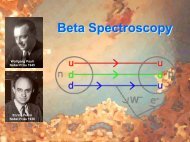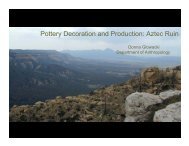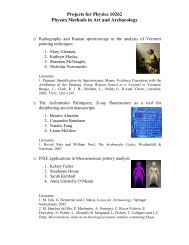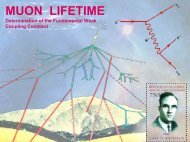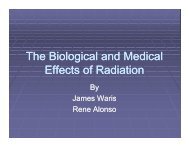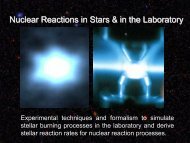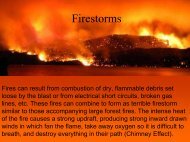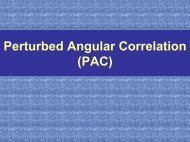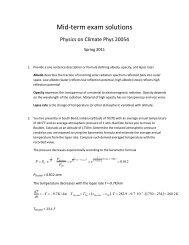Climate Engineering
Climate Engineering
Climate Engineering
Create successful ePaper yourself
Turn your PDF publications into a flip-book with our unique Google optimized e-Paper software.
There is always an easy solution to every human problem –neat, plausible and wrong.<br />
H. L. Menken
The goal: albedo increase<br />
or CO 2 reduction<br />
T e<br />
<br />
4<br />
<br />
<br />
<br />
<br />
1<br />
<br />
4<br />
<br />
<br />
<br />
<br />
F<br />
0<br />
<br />
<br />
<br />
2 <br />
T 4<br />
T s<br />
e<br />
2 <br />
<br />
to reflect more of the incoming total radiation or leak more of the emitted IR radiation<br />
1. Solar reflectors in orbit<br />
1. Carbon sequestration in rocks<br />
2. Cloud Seeding<br />
2. Carbon sequestration in ocean<br />
3. Carbon scrubbing and artificial trees<br />
4. Iron fertilization of phytoplankton<br />
p<br />
1. Aerosols in stratosphere<br />
5. Reforestation and desert greening<br />
6. Genetic engineering of plants
Proposals for changing or <br />
increased inflection of solar radiation or<br />
reduced dabsorption of earth IR radiation
Changing the albedo<br />
• Reflecting mirrors<br />
in orbit<br />
• Cloud seeding<br />
and whitening
Cloud seeding and whitening<br />
d ( l ) h l d<br />
Generating condensation points (aerosols) in atmosphere generates clouds.<br />
If condensation particles are small, cloud will appear white rather than dark!
Clouds are a major component in the albedo estimates of the earth<br />
climate system. Vaporizing seawater and ejecting it into high altitude to<br />
increase cloud density and condensation capability. One Flettner ship has<br />
the capability of processing an amount 10 tons of water/sec. Aerosol<br />
particles injected into water spray create more droplets with a smaller size<br />
distribution. This increases the cloud albedo as clouds appear whiter and<br />
larger, leading to a projected cooling effect of between ‐0.3 and ‐1.8 Wm −2<br />
.<br />
10 ships are proposed to distribute 3800 square miles of ocean for a pilot<br />
project. An efficacy estimate claims a requirement of a 1,900 ship fleet<br />
costing $7.5 billion to maintain temperature balance. (supported by Bill Gates)
Efficacy<br />
1<br />
F0 <br />
8<br />
W<br />
T 4 e<br />
5.67 10<br />
2<br />
4 <br />
<br />
m K<br />
W<br />
F0 1368 for 0.35 Te 250 K<br />
2<br />
m<br />
Reduction of temperature by 5 K<br />
requires an increase in albedo of:<br />
4<br />
4<br />
T<br />
‐0.0080<br />
e<br />
1<br />
0.4 for Te<br />
245K<br />
‐0.0100<br />
F<br />
or<br />
0<br />
16 3<br />
d<br />
<br />
Te<br />
10<br />
6.6310<br />
T<br />
3<br />
e<br />
dT F<br />
e<br />
0<br />
F 1 e<br />
A0<br />
d<br />
A0<br />
1<br />
<br />
2<br />
F0<br />
A dA A<br />
A0<br />
d<br />
dA<br />
2<br />
A<br />
2<br />
A<br />
dA d<br />
0.25<br />
A0<br />
d<br />
( for A 0.5<br />
A0<br />
)<br />
A<br />
0<br />
d/dT<br />
4<br />
‐0.0060<br />
‐0.0120<br />
‐0.0140<br />
‐0.0160<br />
‐0.0180<br />
‐0.0200<br />
200 220 240 260 280 300 320<br />
temperature<br />
this requires an increase of<br />
cloud cover from 50% to about<br />
75%, dim days to come!!!
Changing galbedo by photon scattering<br />
• Atmosphere doping<br />
with aerosols<br />
Smoke and steam hang over the<br />
Eyjafjallajokull volcano in Iceland!
Doping the atmosphere<br />
Natural examples are volcano eruptions emitting large amounts of dust<br />
and sulfuric aerosols into the atmosphere which increase the scattering<br />
probability of incoming solar radiation and therefore the albedo factor.<br />
El Chichon 1982 Pinatubo 1991<br />
F ( <br />
) <br />
K<br />
,<br />
x<br />
<br />
dx<br />
<br />
<br />
na<br />
<br />
<br />
(<br />
,<br />
x<br />
<br />
dx<br />
e e<br />
)<br />
0<br />
( )<br />
F
The idea‐ mimic the cooling effect of<br />
Pinatubo eruption<br />
Manually inject aerosols into the<br />
stratosphere by plane<br />
1.5‐5 Tg S per yr needed to offset<br />
warming [Rasch et al. (2008)]<br />
Removal probability:<br />
Paul Crutzen<br />
Nobel Laureate<br />
advocate of sulfate aerosols<br />
K<br />
<br />
extinction<br />
K<br />
scattering<br />
K<br />
absorption<br />
Mie scattering on aerosol or<br />
dust sized particles is more<br />
efficient for high energy (small<br />
wave length) solar radiation<br />
than Rayleigh scattering for low<br />
energy (high wavelength) IR<br />
radiation from earth. Increases<br />
reflection of incoming light with<br />
limited effect of IR emission!
Mie scattering is preferably in forward<br />
direction, it generates halo around sun or<br />
moon or other light sources<br />
x<br />
r<br />
<br />
2 m: index of refraction for<br />
different scattering media,<br />
m=0 means no scattering.<br />
The parameter x corresponds to the ratio of size<br />
of scatter medium to scattered wavelength; x is<br />
large for large particles and short wavelengths.<br />
Maximum scattering probability is at x=3‐5!
Sulfate delivery systems<br />
<br />
<br />
Sulfate particle injector mounted aboard aircraft platform<br />
Sulfur‐enhanced fuel additives, emit aerosol precursors in jet exhaust stream<br />
Jet‐fighter carrying 10 metric tons<br />
each jet distributes payload in 4 hrs, over 2500 miles<br />
would require 1 million such flights per year!<br />
would cost $25 to 50 billions annually
A schematic of the processes that influence the life cycle of stratospheric<br />
aerosols (adapted with permission from SPARC 2006).<br />
Sulfate fall‐out would eventually be deposited in polar regions
The surface temperature difference from during June, July and August with the<br />
2×CO 2 simulation and the geoengineering simulation using 2Tg Syr −1 emission<br />
(which is not sufficient to entirely balance the greenhouse warming).<br />
The simulations indicate<br />
an efficient cooling effect!<br />
Rasch P J et al. Phil. Trans. R. Soc. A 366, 4007 (2008)
Natural washout from the atmosphere with rain after<br />
some months<br />
SO2 OH 3H<br />
2O<br />
H<br />
2SO4<br />
2H<br />
2O<br />
Conversion of ejected gaseous SO 2 into H 2 SO 4 within<br />
six months, production of hd hydrosulphuric lh acid, that<br />
translates into acid rain<br />
Clear increase of stratosphere<br />
p<br />
temperature by ~4 o , while observing<br />
a limited decrease of temperature in<br />
hemisphere by only ~0.2 o . Long<br />
term balance between atmospheric<br />
and surface temperature will<br />
require new seeding.
Changing the atmosphere absorption<br />
by carbon sequestration<br />
• Carbon Storage<br />
Problem of site<br />
identification<br />
with no leakage<br />
• Artificial trees and<br />
carbon scrubbing
Carbon sequestration by “artificial trees”<br />
One solution, long term<br />
storage in underground<br />
cavities; could also be<br />
injected into declining oil<br />
fields to increase oil<br />
recovery!<br />
Ca(OH) 2 + CO 2 → CaCO 3 + H 2 O<br />
Second solution is the<br />
chemical processing for<br />
converting the CO 2 into<br />
building material or more<br />
complex, useful chemical<br />
substances!
Possible position near oil fields,<br />
chemical plans or other convenient<br />
locations of high CO 2 emission<br />
probability (highways, industries) to<br />
increase the overall collection<br />
efficiency.<br />
The present tree design absorbs<br />
5000 _ tons of CO 2 per year. For an<br />
annual CO 2 emission of about<br />
10 10_ tons/year roughly 2,000,000<br />
trees are required. The estimated<br />
operation costs of about $50 per ton<br />
translates into annual costs of US<br />
$25 _ trillion annually (worldwide)!<br />
With a world population of 7 billion<br />
people this translates into annual<br />
costs of $3600/person.
Ocean fertilization<br />
Phytoplankton: basis of food chain, major absorber for CO 2
‣ Fast growth rate of phytoplankton makes<br />
it more efficient i than land dbased plants,<br />
‣ Smaller fraction of absorbed CO 2 is<br />
reemitted by respiration process<br />
( deep sea mixing, CaCO 3 skeleton structure)<br />
‣ Efficient up‐take of Dissolved Inorganic<br />
Carbon (DIC) molecules l such as CO 2<br />
Riebesell et al. Nature 361, 249 (1993)
Southern Atlantic coast of South America<br />
Iron fertilization of cool ocean water<br />
areas is expected to stimulate a<br />
phytoplankton bloom. This is intended<br />
to enhance biological productivity, to<br />
strengthenthemarinefoodchainand<br />
remove CO 2 from the atmosphere since<br />
iron is atraceelement for plant based<br />
photosynthesis and is often a limiting<br />
nutrient for phytoplankton growth. It<br />
was demonstrated in the 1995 IronEX II<br />
experiment that large phytoplankton<br />
blooms can be created by supplying iron<br />
to iron‐deficient ocean waters. In the<br />
experiment 450 kg of FeS have been<br />
distributed over 18 days into the Pacific<br />
ocean. A plankton bloom developed<br />
rapidly turning the waters brown. It was<br />
estimated from plankton density<br />
samples that the plankton consumed<br />
nearly 2500 tons of CO 2 , significantly<br />
reducing the concentration of CO2 in<br />
the ocean patch from its original value.
IronEX II Experiment 1995<br />
K. Coale et al. Nature 383, 495 (1996)<br />
Vertical ltemperaturet<br />
SF 6<br />
tracer<br />
Iron concentration<br />
Chlorophyll bloom<br />
Nitrate generation<br />
CO 2 fugacity
BasedontheIronEXIIresultsit<br />
was estimated that a fraction of<br />
20% of the ocean area needs to<br />
be fertilized to induce sufficient<br />
i<br />
CO 2 absorption for reducing<br />
atmospheric CO 2 levels to year<br />
2000 values.<br />
Model prediction are promising (http://www.esse.ou.edu/~gromine/iron.html)<br />
but a large number of potential site effects primarily from secondary ocean<br />
chemistry are envisioned associated with the release of chemicals from<br />
plankton and algae growth and algae death and decay processes.<br />
Additional experiments have been carried out in the last decade: SOIREE,<br />
EisenEx, SEED, SOFeX, Planktos, SERIES, and EIFEX, primarily in the Southern<br />
Pacific and Indian Ocean to explore the biogeochemistry of iron fertilization in<br />
iron limited waters .
Long term effects are still unknown!<br />
The 1999 Southern Ocean Iron RElease Experiment SOIREE experiment<br />
suggests dangers of fertilization to<br />
the ecosystem structure. The<br />
clearly visible curved plankton<br />
growth distribution in the<br />
satellite picture is due to ocean<br />
currents .<br />
Results indicate that efficacy of CO 2<br />
absorption is smaller than originally<br />
anticipated. Potential dangers are<br />
in algae bloom due to overnitration<br />
as consequence of iron fertilization,<br />
which could reduce oxygen levels<br />
seriously affecting marine life!
Cost benefit analysis<br />
The ranking of “promising“ geoengineering proposals in<br />
terms of efficacy and promise (based on theoretical<br />
prediction and pilot studies), costs and affordability, risk<br />
and safety (in terms of possible site effects).<br />
P. W. Boyd, Nature Geoscience 1, 722 (2008)
The political and science community<br />
is prepared and remains optimistic isti ...<br />
CR





